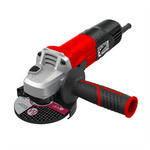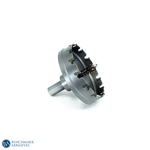
Cold Welding Vs TIG Welding
In the field of metal fabrication, two pieces of metal can be joined in a variety of ways. While many people think of welding as a process that always involves intense heat and fire, that's not always the case. Two distinct and powerful methods for joining metals are cold welding and TIG welding.
TIG welding is a heat-based process for precise joins, whereas cold welding is a pressure-based, solid-state method. Understanding their fundamental differences is essential for choosing the right method for a specific job.
This post will explain the definition, operation, advantages, and disadvantages of both welding processes.
Cold Welding
Solid state welding, sometimes also called cold welding, is a special technique that joins two pieces of metal without the use of external heat. Instead, a huge amount of pressure is applied to the two workpieces, forcing them together so closely that the metal atoms bond to each other. This creates an almost perfect, seamless bond with no liquid or molten metal involved. To achieve this, the metal surfaces must be meticulously cleaned to remove any oxide layers or impurities that could prevent a bond.
There is only one true form of cold welding. Other processes like Cold Metal Transfer (CMT) and Cold TIG welding are actually low-heat arc welding methods, not true cold welding. Epoxy bonding is a different process altogether and isn't a form of welding.
Applications of Cold Welding
Cold welding is highly valued in industries where applying heat would be dangerous or destructive, such as electronics, aerospace, and the automotive sector. It's often used for joining wires, especially those made of dissimilar metals that are otherwise difficult to weld, like aluminum and copper. It is also ideal for sealing heat-sensitive containers, such as those that hold explosives or other volatile materials.
Pros and Cons of Cold Welding
Pros:
- Eliminates Heat-Affected Zone (HAZ) Issues: Since no heat is used, there is no HAZ, which means the metal's properties and strength are not altered in the joint area.
- Joins Dissimilar Metals: Cold welding is one of the best methods for joining a wide variety of dissimilar metals, including aluminum, copper, lead, and gold.
- Creates Flawless Joints: The process creates a nearly perfect bond that is free of microfractures and brittle intermetallic compounds, which can weaken a joint.
Cons:
- High-Level Surface Preparation: The success of the weld is entirely dependent on having a meticulously clean surface, which can be challenging to achieve in an industrial setting due to airborne contaminants.
- Limited to Specific Metals: Cold welding is only applicable to non-ferrous, soft metals. It cannot be used on carbon steel or other hardened metals.
- Not Ideal for Irregular Shapes: The most reliable results are obtained on flat, simple surfaces, as achieving the necessary pressure on irregular shapes is challenging.
TIG Welding
Arc welding includes tungsten inert gas (TIG) welding. It melts and fuses metal by producing a steady, focused arc using a non-consumable tungsten electrode. The weld region is shielded from air contamination by a protective gas, usually pure argon or a combination of argon and helium. This allows for a very clean and aesthetically pleasing weld.
Applications of TIG Welding
TIG welding is highly regarded for its accuracy and capacity to create incredibly clean welds. For welding rare and exotic metals like aluminum, titanium, stainless steel, and chromoly, it is the preferred technique. Because of the high level of control over the arc and heat input, TIG welding is also used on ordinary mild steel when exact joint quality and a high-end finish are required, such as in art or high-end fabrication.
Pros and Cons of TIG Welding
Pros:
- Unmatched Precision: TIG welding offers the highest level of control over the arc and heat, allowing a skilled welder to make incredibly precise and clean welds.
- Ideal for Thin Metals: This process is perfect for welding thin materials without burning through them, making it valuable for aerospace and automotive bodywork.
- Clean and Aesthetically Pleasing: TIG welds are smoke- and splatter-free and do not require flux, resulting in a clean process and beautiful, appealing welds.
Cons:
- High Skill Requirement: TIG welding is notoriously difficult to learn and requires a great deal of skill, practice, and a steady hand.
- Slow Process: It is a labor-intensive process that can be much slower than other welding methods like MIG welding, which can decrease productivity.
- Susceptible to Wind: The shielding gas can be blown away by wind, making it challenging to perform TIG welding outdoors.
Read More: Difference Between MIG and TIG Welding
Summary: Cold Welding vs. TIG Welding
| Feature | Cold Welding | TIG Welding |
| Joining Method | Pressure (Solid-state) | Heat (Arc) |
| Material State | Solid | Molten (Liquid) |
| Best For | Dissimilar metals, non-ferrous, ductile metals, and heat-sensitive applications. | Precision, thin stock, rare metals, and aesthetically critical welds. |
| Skill Level | Surface preparation is crucial; physical technique is less of a factor. | High skill and practice are needed to control the arc and heat. |
| Safety | Safer in volatile environments since no heat is generated. | Safer for the surrounding metal, but still requires safety gear and a well-ventilated space. |
| Result | A seamless, flawless bond without a heat-affected zone. | An incredibly precise and clean weld with a minimal heat-affected zone. |
Ultimately, the choice between cold welding and TIG welding depends on the material, the finish required, and the application.




































































